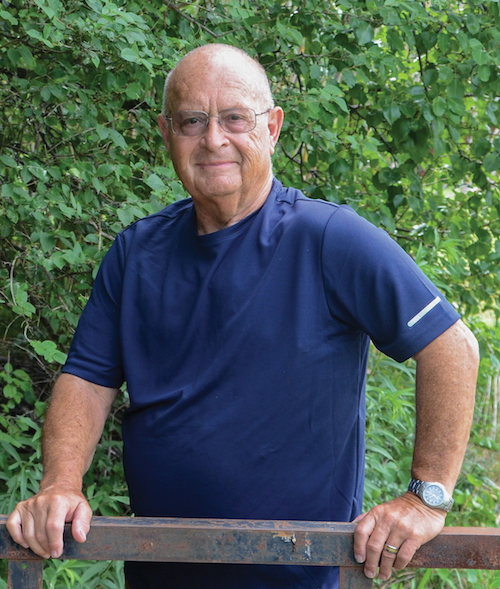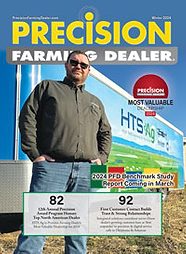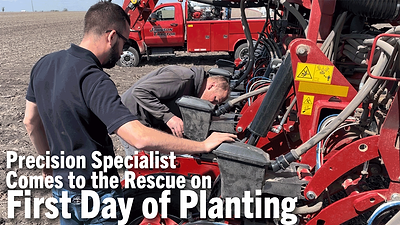With principal involvement in three busy agricultural enterprises, Jason Mauck, 40, has to be constantly thinking, planning and doing to keep all the balls in the air as he juggles traditional family farm management, off-farm agronomic innovation, and the headaches and highs of innovating a new direct-marketing meat business.
Mauck manages day-to-day operations of Mauck Land, Hog and Cattle Co., a multi-generational corn and soybean farm near Gaston, Ind. In addition, the farm finishes 25,000 hogs per year and meets much of the corn and soybean nutrient needs with effluent from the livestock. He’s also a partner with Jonathan Lamb in Constant Canopy, a non-traditional “innovation farm” where the pair is producing wheat and soybeans interseeded on the same fields behind an oat/radish cover crop. Plus, he’s spearheading the renovation of Munsee Meats, a long-time local meat supplier to the area restaurants — with eyes on building it into a cold storage outlet to deliver direct-to-consumer locally-produced farm products through social-media-driven online sales.
Fork In the Road
Agriculture, Mauck says, is at a fork in the road where the choices are “get bigger and swallow smaller operations” or move closer to the customer and harvest additional dollars through direct marketing.
“My focus is complete vertical integration and building a strong customer base,” he says.
“The older farm generation faced different circumstances as they grew their farms and involved their children and their families in the business. We can’t do that today. We can’t grow 100-bushel corn and make a 40% margin,” he explains.
“To survive the next 10 years and beyond, our generation will have to create ways of meeting the customer while at the same time tackling the challenges of profitable production and direct marketing,” he says.
“In my own case, I know I can’t be the dad and husband I need to be trying to do all this by myself, so a lot of our success will depend on developing human capital. I have to be able to identify employees I can trust to help grow our businesses, and let them make mistakes and take responsibility.
“I don’t really want more acres, I need customers for what I produce to make those acres worth more, and to do that I have to be in the ‘people’ business. There are currently 20 people involved in the three enterprises, so the end-user customer has to be my focus to remain profitable,” he says.
Mauck believes the key to successful personnel management is to create venues that allow employees to develop their full potentials and interact with as many others as possible.
“Those employees will foster many new relationships which ultimately will benefit their employer by introducing new customers and suppliers to the equation,” he explains. “Connecting people with other people, in person and through social media, is the way you build a customer base.”
Mauck says it’s difficult to quantify the benefits of social connections in dollars and cents, but says his own experience re-launching Munsee Meats with a highly-motivated and well-connected set of managers is a good example.
“When I share my ideas at conferences, or in public speaking engagements, many people take an interest and learn more about me. My credibility and that of my message grows, and people who are interested in my ideas will follow me on social media, etc.
“By being an open source of information and ideas, people can build a following of like-minded individuals,” he explains. “That’s why when it came time to build a management team for Munsee Meats, I was able to tap four extremely bright, knowledgeable and energetic people willing to take on the challenge of launching a new business model. They essentially came to me, and with them they bring very valuable networks of other bright, knowledgeable and energetic people.”
Mauck says he has faith in the coterie of managers at Munsee Meats and knows, in time, the business will be collecting premiums from selling high-value products identified with so-called socially-responsible production practices.
“The further you get from the farm the closer you get to downtown Chicago, New York and other urban areas, places where many consumers are willing to pay a premium for these things,” he explains. “We’ll get there, but it doesn’t happen overnight.”
Controlling Debts
Mauck says his family’s traditional farm and land base has been debt free for a long time due to frugality through the era of farm program payments for commodity production.
“We buy pre-owned equipment and use it a long time. Because of that, upgrading equipment will be a slow process in that part of our business,” he explains, noting the influence of several generations still active on the farm.
“Having new equipment is not a priority of mine, because our situation is different than many. We have 4 million gallons per year of hog effluent to use on our crops unlike many traditional conventional farms.
“Making wise use of our nutrient and water resource is a much higher priority to me than spending $500,000 on the latest high-tech planter because it allows a less-expensive way to boost yields. The planter might give us 5-10 bushels per acre more production, but because we have the manure and slurry keeping our per-acre input costs low, the production increase of the new technology doesn’t make economic sense.”
Mauck says there are also other advantages to not owning the latest iteration of technology.
“We run a 36-row 20-inch, all-mechanical planter we purchased in 2008,” he explains. “It isn’t as efficient as what’s available today, but I can fix it in the dark at 2 a.m. if I have to.
“That makes a difference when I’m trying to time 1,500 acres of planting in a four-day window to maximize my profits. If I had the newest technology which locks me out of doing my own repairs, I might be down for two days waiting on service — and two days will cost me money in production at the same time the new planter would still be costing me money in interest and depreciation.”
Expenses Spawn Opportunity
As prices for new, more-complex equipment continue to rise, Mauck says he foresees more growers forming cooperative agreements to own equipment together, and he sees the potential for new niche businesses which could specialize in maintaining older equipment (that without proprietary software).
Also, he says opportunities may exist for an ‘Uber-like’ business model where businesses form to run and maintain the latest equipment for farmers, who would buy their custom harvesting and planting services.
On his Constant Canopy acres, however, he’s inventing, developing, and building equipment necessary to accomplish the projects and experiments he’s tackling there, such as strip planting and interseeding, non-traditional corn and soybean planting rates, various-length seed spacing for improved use of sunlight, and extensive use of cover crops.
Despite his successes at Constant Canopy over the last 5 years, Mauck says he’s disappointed the Farm Service Agency (FSA) doesn’t recognize innovation or its positive outcomes. Using alternate innovative techniques has multiple environmental and production advantages, but the FSA doesn’t provide insurance programs for it, he says.
“I’ve worked with private insurers to cover my relay-cropping of wheat and soybeans with revenue protection, but when you approach FSA, they want 50% of the acres in a wheat mono-crop and the other 50% solely in beans.
“The idea of growing the crops in a manner that produces less yield, but at a much higher economic margin just doesn’t work with their models,” he says. “It’s tough to compete when the government program is aimed at maximum yield and the ‘get bigger’ mindset. That’s why I’m moving to vertical integration to get closer to the end-user’s purchasing power.”
To do that, Mauck says growers in the 2020s will have to leverage their farm data to prove they’re using fewer chemicals and less commercial fertilizer to craft a positive story for the increasingly environmentally-conscious consumer.
Data-Driven Marketing
Mauck says he’s trying to get beyond being just a direct-marketing label to building lasting relationships with consumers who want to know how their food is being raised.
“Creating a credible supply of grain that can be traced to environmentally-responsible production practices is of value to the end-user,” he says, citing the experience of one of his neighbors who commands a 15% premium over commodity prices by trucking non-GMO food grade crops to a market in Indianapolis.
“I don’t want to get into the trucking business like my neighbor, but his business shows crop identity preservation can be an economic force multiplier far more effective than just trimming cost through high-tech systems and taking on additional acres.
“Technology to track production records of crops is growing by leaps and bounds and we can use it to leverage ourselves as value-added suppliers to our consumers,” he predicts. “These systems will be one of the more valuable results of ag tech development over the next 10 years.”
Mauck is taking this concept a step further and going directly to the consumer with certain products.
“We just purchased Munsee Meats, a locally owned USDA meat processing plant that has supplied the restaurant trade since 1957, and they had their whole business model turned upside down with COVID. Our goal is to turn it into a cold-storage operation where producers will bring their fresh meat products,” he explains. The business will create a way for consumers to hear ‘their’ farmers’ stories and have convenient access to quality products.
“Folks will be able to go to a website and order honey, poultry, beef and pork, all with identity preserved production records and introductions to the farms on which they were produced. We’ll stock their order immediately and give them a locker access code,” he says.
“To begin, 95% of what we’ll sell will be what you could buy in a small town grocery story — Cargill, ConAgra, etc. Then, we plan to have an Indiana Prime premium label of higher-priced products. Finally, we’ll be offering the meats and produce sourced from local cooperating farmers. Those will also be priced higher because of the labor and other costs involved, but people will be supporting local agriculture and can know their suppliers,” he explains.
Over time, Mauck says he sees the first two segments of the business plan supporting the locally-produced segment until a critical mass of consumers become aware of it, and word-of-mouth and social media build its place in the market.
Remaining Profitable
Looking at 2030, Mauck says he plans to grow his businesses and remain profitable by continuing to diversify when opportunities present themselves, along with seeking ways to reduce risk and control debt.
“We have a profitable farm, a contract for the pigs, manure for the crops, and good relationships with our neighbors,” he explains. “Right now our bottom line doesn’t move on commodities, and that’s a good thing.
“Overall, improving efficiency in our businesses will hinge on improving our customer base,” he explains. “I can keep wringing costs out of production and grow corn cheaper, but if I can create more value for what I produce on our existing land base and attract more customers, I don’t have to achieve maximum production. I can boost overall efficiency through more profits per acre.”
Learn More
-
8 Tips for Building Better Dealer-Farmer Precision Partnerships
Three farmers and three precision equipment specialists discuss strategies for anticipating service needs, maximizing sales opportunities and avoiding customer conflict.







Post a comment
Report Abusive Comment